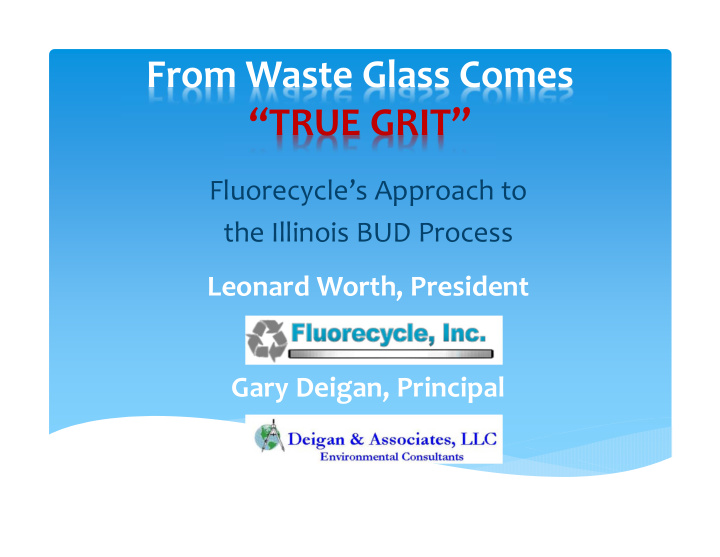



From Waste Glass Comes “TRUE GRIT” Fluorecycle’s Approach to the Illinois BUD Process Leonard Worth, President Gary Deigan, Principal
About Fluorecycle
Fluorecycle Recycles Mercury ‐ Containing Lamps Processes 3 million lamps annually Mercury recovered Lamp components recycled
Fluorecycle Generates 600 tons of Glass Cullet Annually
Alternatives Considered for Glass Cullet Re ‐ Use Admixture for asphalt Admixture for concrete Grit media for sand/grit blasting
Glass Cullet Recycling/Re ‐ Use Alternatives Each Recycling Approach Required Additional Mechanical Processing and Determination of Safe Chemical Content Grain Size Chemical Analysis ‐ Mercury
Typical Chemical Composition Typical Fluorecycle Glass Cullet Data 0.0003 to 0.0086 mg/L TCLP (Hg) 1.39 mg/kg Total (Hg) Comparative IEPA Standards Background Soil (Hg) 0.06 mg/kg Metropolitan Areas 35 IAC 742-Tier 1 Soil (Hg) Ingestion 23.0 mg/kg Inhalation 10.0 mg/kg Soil Migration to Ground Water (Hg) Class I GW 0.002 mg/L Class II GW 0.01 mg/L
Feasibility Analysis/Economics of Glass Cullet Processing/Recycling End Users for material Landfill Disposal Costs Capital Equipment O&M Costs Regulatory Financing
Timely Factors Illinois DCEO / ARRA Grant Funding IEPA Beneficial Use Determination (BUD)
IL DCEO/ARRA Green Industry Business Development Grant $445,417 Grant Funds Received 1:1 Match Funding Required Timeframe Funds: February 2009 to 2012
Beneficial Use Determinations SB 2034 (Garrett, D ‐ Lake Forest), authorizes the IEPA to make written determinations that certain materials that would otherwise be required to be managed as waste may be managed as non ‐ waste if those materials are used beneficially and in a manner that is protective of human health and the environment. The bill requires applicants for beneficial use determinations to demonstrate that: (1) the chemical and physical properties of the material are comparable to similar commercially available materials, (2)the market demand for the material meets certain requirements, (3) the material is legitimately beneficially used, (4) the management and use of the material will not cause, threaten, or allow the release of any contaminant into the environment, except as authorized by law, and (5) the management and use of the material otherwise protects human health and safety and the environment.
415 ILCS 5/22.54 Beneficial Use Determinations “Not a waste”, if: 1. Chemical and physical properties comparable 2. Market demand for the material 3. Material is legitimately beneficially used 4. Material will not cause release to environment 5. Use protects human health, safety, environment
IEPA BUD Approval
“TRUE GRIT” Production
“TRUE GRIT” Packaging for Re ‐ use
Challenges Being Worked Out… Screen Size to minimize regrinding to grit spec Add magnets to drop chutes to capture small steel fraction Cullett spillage/ 1 st conveyer transfer to hopper Material Sales vs. Donation
Economics/Production Glass Re ‐ use Capital Equipment/Start ‐ up: $140,000 (50% ARRA Funds) Prior Annual Glass Disposal Costs: $40,000 to $50,000 Approximate 2 to 3 year payback period 40 to 60 tons/month grit shipped for re ‐ use
Re ‐ use as Grit Blasting Media
Contact Us Leonard Worth Sales@fluorecycle.com 815/363 ‐ 4411 www.fluorecycle.com Gary Deigan gdeigan@deiganassociates.com 847/578 ‐ 5000 www.deiganassociates.com
Recommend
More recommend